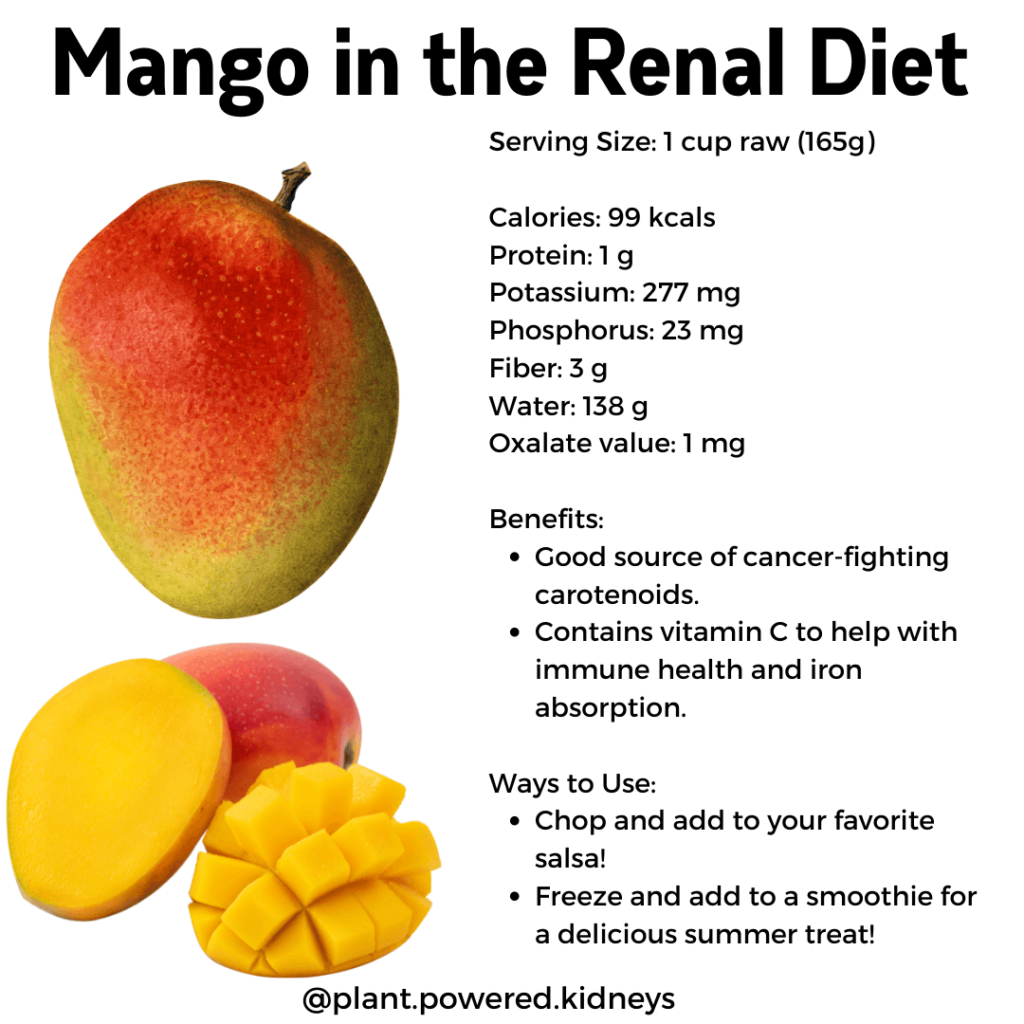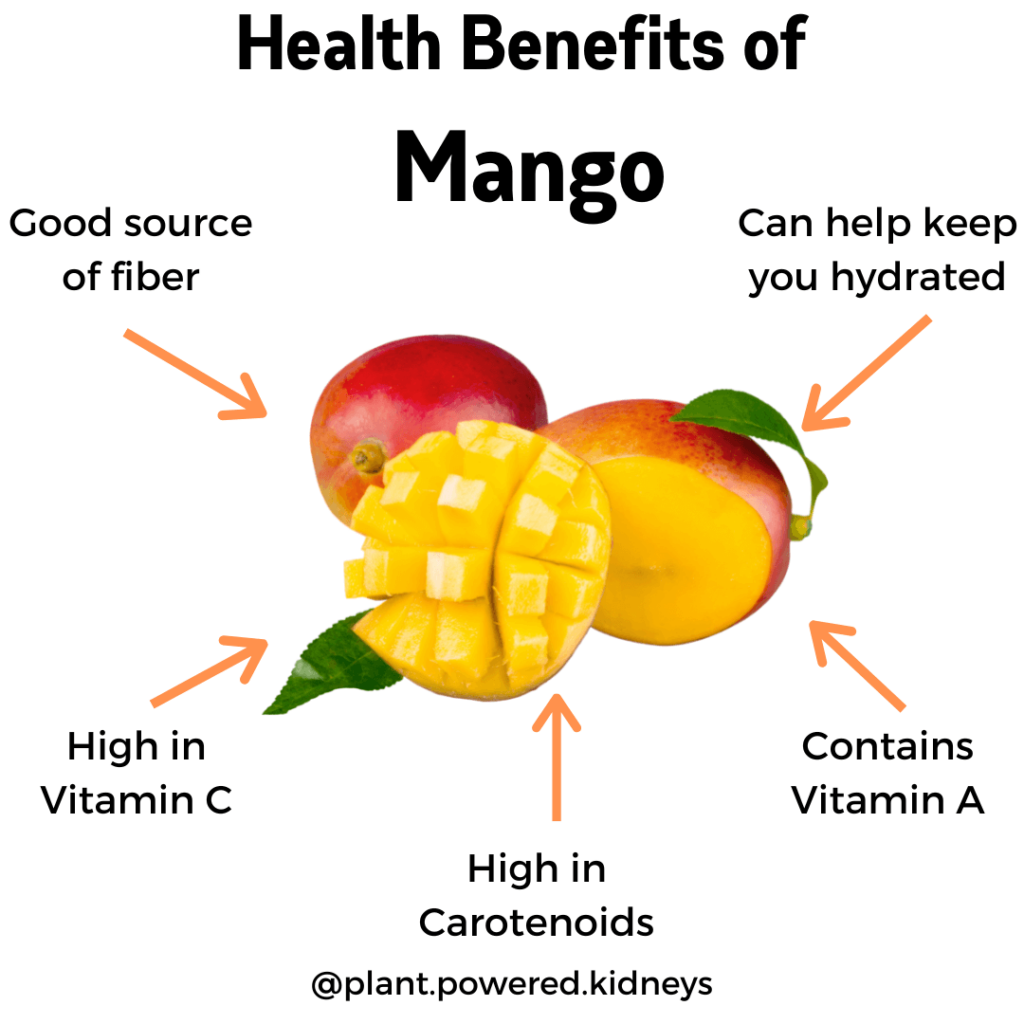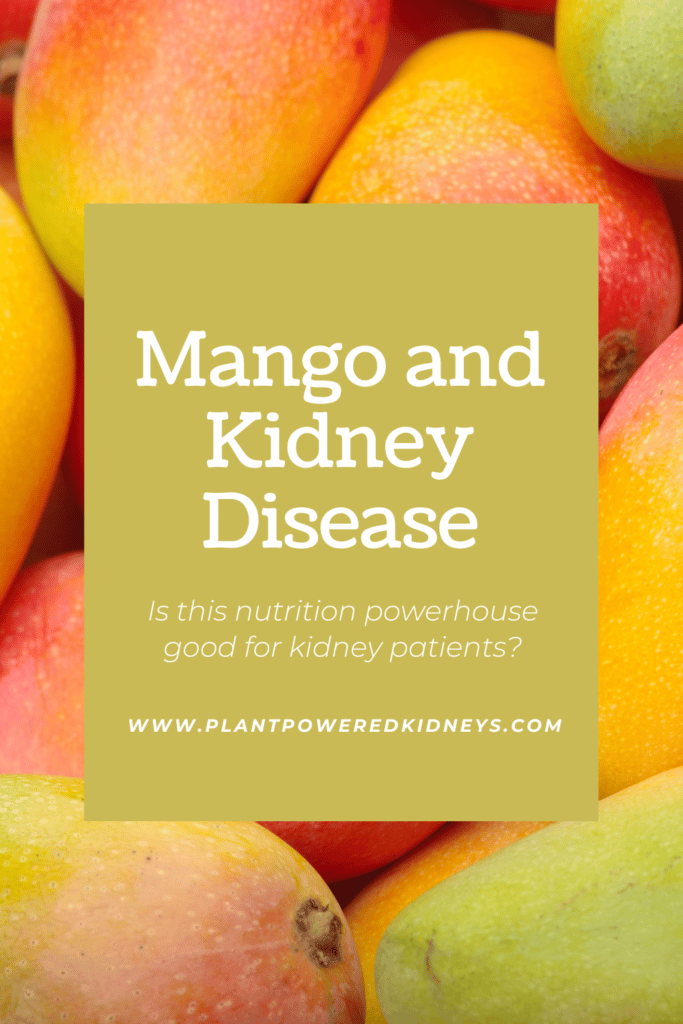Known as the “King of Fruits,” mango is a popular and delicious summer fruit. Filled with health-promoting nutrients and a unique sweet flavor, it’s no wonder the mango is growing in popularity across the globe. However, you may be asking yourself, “Is Mango Good for Kidney Patients?” Mangos are a nutrition powerhouse. However, there are some instances where certain kidney patients need to be cautious with mango. Let’s dive in and understand the real deal with mango and kidney disease!

Table of Contents
Mango 101
Mango is a popular summer fruit with a delicious and unique taste and lots of vitamins and minerals.
However, many still want to know, is mango good for kidney patients?
Let’s start with where mangos come from. Most mango crops come from Asian countries, particularly India.
Mangos belong to the Anacardiacae family.
The mango has three different parts: the pulp, the peel, and the kernel. The pulp is the most frequently eaten part of the fruit and contains lots of different vitamins and minerals.
However, the other parts of the mango contain important nutrients as well.
The pulp, also known as the mesocarp, is what most of us think of when we think about eating mango.
This part of the mango is what is used to make mango juice, jellies, and jams as well as the plain raw fruit.
The pulp of the mango contains mostly carbohydrates and some protein. It also contains noteworthy micronutrients such as Vitamin C, Vitamin A, and potassium.
Mango Nutrition and Health Benefits

Vitamin C
The mango pulp is high in Vitamin C, which is very important for our general health (and kidney health!).
Vitamin C is an antioxidant. An antioxidant is a substance that can help stop or slow down damage to our cells.
Equally important, Vitamin C can help keep our immune system healthy. It can also help our bodies absorb iron (think anemia and blood health!).
100 grams of raw mango contains about 36 mg of Vitamin C.
The recommended daily allowance for Vitamin C for adults 19 years or older is 90 mg for males and 75 mg for females.
Consuming mango can be a great way to help meet your daily Vitamin C requirements!
Vitamin A
The pulp of the mango also includes high levels of Vitamin A.
Vitamin A helps with our immune health, the health of the cells in our bodies and our eye health.
The recommended daily allowance for Vitamin A for adults 19 years or older is 900 mcg for males and 700 mcg for females.
A 100g serving of mango has 54 mcg of Vitamin A.
For more information about vitamin A, check out our article about Vitamin A and kidney disease.
Carotenoids
Do you ever wonder what gives mango its distinct color? Carotenoids are responsible for the beautiful yellow, orange and red colors that we see in the mango.
Carotenoids are pigments that are found naturally in foods that may have benefits to our health.
One of the most common carotenoids found in mango is called beta-carotene.
Beta-Carotene is converted to Vitamin A in our bodies and can help protect our cells against damage.
Studies have found that diets that contain fruits and vegetables that have high amounts of carotenoids (mangos, hint hint!) may help fight against certain diseases, particularly cancer.
Potassium
What about the potassium in mangos? Yes, mangos do contain potassium.
Studies have linked a healthy potassium intake (coupled with a low sodium diet) to better heart health, especially better blood pressure control.
Mangos can help you increase the amount of potassium in your diet, helping you be kinder to your heart.
Some people with kidney disease, however, need to follow a potassium restriction.
If you have a potassium restriction given by your doctor or dietitian, be sure to ask how you can fit mango into your diet.
Portion size is key! 1 cup of raw mango contains 277 mg of potassium. This is considered high potassium.
However, a ½ cup of raw mango contains approximately 139 mg of potassium, which is considered low potassium.
Click here to learn more about the low potassium diet!

The Peel and the Kernel
The peel and kernel are the other two parts of the mango that are less commonly eaten.
The peel, similar to the pulp, contains fiber, Vitamin C and carotenoids.
Due to this high level of nutrients, the peel is sometimes processed and added into food supplements.
However, the peel usually just goes to waste.
The kernel, also referred to as the mango seed kernel, has different uses.
Compared to the peel and the pulp, the mango seed kernel has a higher amount of fat (also called lipids).
This can be processed and turned into mango seed oil, which is structurally and chemically similar to cocoa butter.
Mango seed oil is not very common, but can be used to cook and make chocolate.
Is Mango Good for Kidney Stones?
So, we answered the question “Is mango good for kidney patients?” However, now let’s ask the question, “Is mango good for kidney stones?”
First, you need to know what type of kidney stones you have. If you don’t know what type of stone you have, ask your doctor!
The type of stone can help determine the best diet for you and your kidneys.
If you have calcium oxalate stones, your dietitian might tell you to lower the amount of oxalate in your diet.
Raw mango and mango juice have a low oxalate content.
At the moment, there are no studies that directly measure if mango is good for kidney stones.
However, we do know that a diet that is high in fruits and vegetables may help prevent kidney stones from forming in the first place or coming back if you have already had them.
Including whole mangos can help you increase the amount of fruits and veggies in your diet!
Can I Eat Mango If I Have A Fluid Restriction?
Some people with kidney disease need to follow a fluid restriction. Fluid restrictions can help take care of your heart.
It can help make sure the heart does not have to work too hard to pump excess fluid.
You do want to make sure that you consider mango if you have a fluid restriction. In 1 cup of raw mango there is 138g of water.
This is equivalent to 138 ml of water. This needs to be factored into your daily fluid intake.
If you need to follow a fluid restriction, chat with your dietitian about how to fit mango into your daily fluid requirements!
Check out our article about fluid restrictions here!
Different Forms of Mango
There are many different ways that you can eat a mango! We want to focus on including the whole fruit, rather than just fruit juice.
The whole fruit will have more nutrients, particularly fiber! This can contribute to better heart health and blood sugar control.
Frozen mango can oftentimes be a less expensive option and usually lasts longer than fresh mango.
Frozen mango does great in smoothies or can be eaten by itself!
| Form of Mango (Per 100g) | Protein | Potassium | Phosphorus | Fiber | Vitamin C | Beta-Carotene |
| Raw Mango | <1g | 168mg | 14mg | 2g | 36mg | 640µg |
| Canned Mango | <1g | 114mg | 10mg | 1g | 21mg | 408µg |
| Frozen Mango | 1g | 168mg | 14mg | 2g | 36mg | 640µg |
| Dried Mango | 2g | 279mg | 50mg | 2g | 42mg | 786µg |
| Mango Nectar | <1g | 24mg | 2mg | <1g | 15mg | 402µg |
When choosing a canned, frozen, dried or juice form of mango, be sure to check the ingredients list.
We want to focus on products that have little to no added sugar, sodium or phosphorus and potassium additives.
That’s it. Apple + Mango fruit bars are a great example of a product with no unnecessary additives or ingredients!
How to Cut a mango
Unsure of how to cut or eat a fresh mango?
There are some easy tips and tricks to make eating mango a mess-free experience.
The mango has one rather large seed smack dab in the middle of the fruit. The seed is what makes slicing the mango tricky for lots of folks.
There are mango splitters that are available for purchase.
However, using a clean, sharp knife can work just fine!
- First, wash the mango and grab a cutting board.
- Next, lay the mango on its side and locate the center. The center of the mango is where the seed will be. ¼ of an inch on either side of the center, make a slice all the way through.
- Once you have your two side slices, slice the mango as you like. You can make strips or a grid, just make sure not to cut all the way through the skin.
- Scoop out with a spoon and enjoy!
Ways To Use Mango In Your Kidney-Friendly Diet
Ready to put your mango cutting skills to the test? Try these easy kidney-friendly ways to include mango.
Smoothies
Grab some frozen mango and blend into a refreshing smoothie!
Ice-Cream Alternative
Blend plain frozen mango and your plant milk of choice to make a kidney-friendly “nice-cream”.
Sweet Topping
Use as a topping for yogurt, acai bowls or a fruit pizza!
Fruit Kebob
Use fresh mango and your other favorite summer fruits to make fruit kebobs.
Salsa
Try a mango salsa! The mango adds a delicious sweet flavor which can help you cut back on the salt.
Grab some low sodium tortilla chips and enjoy as a light and delicious summer snack!

The Bottom Line: Is Mango Good For Kidney Patients?
So, is mango good for kidney patients? Short answer, yes.
Mangoes are full of vitamins, minerals, antioxidants and phytochemicals (plant chemicals!) that can be beneficial to our health.
There are some instances where you might need to be cautious with mango.
Kidney patients might need to be cautious if they have a potassium restriction or a fluid restriction.
With the help of your dietitian, you can incorporate mango into your diet and enjoy this “King of Fruits” this summer.


